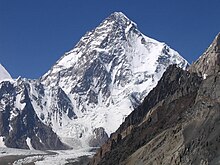Western Himalayas

The Western Himalayas refers to the western half of the Himalayas, stretching from Badakhshan in northeastern Afghanistan/southern Tajikistan, Pakistan through northwestern India. It is also known as the Punjab Himalayas. All five tributaries of the Indus River in Punjab (Beas, Chenab, Jhelum, Ravi, and Sutlej) originate from the Western Himalayas.
Included within the Western Himalayas are the Zanskar Range, the Pir Panjal Range, and the Dhauladhar Range, and parts of the Sivalik Range and the Great Himalayas. The highest point is Nanga Parbat (26,660 feet or 8,126 metres), at the northwestern end of the region.
Rivers[]
The Jhelum river rises in the Pir Panjal Range in Indian-administered Jammu and Kashmir, and flows northwestward through the Vale of Kashmir before entering Pakistani-administered Azad Kashmir and eventually entering the plains near Mirpur. The Chenab river originates in Himachal Pradesh near Chandra Taal and forms the Lahaul Valley in the state and the Chenab Valley in neighbouring Jammu before entering the plains near Akhnoor. The Ravi river which flows through the Chamba Valley and the Beas river which flows through the Kullu and the Kangra valleys both originate in Himachal Pradesh state as well. The Sutlej river rises in Tibet, enters Himachal Pradesh near Shipki La pass, flows through Kinnaur where it is joined by its tributaries Spiti and Baspa, before entering the plains near Ropar in Punjab.
Ecology[]
Flora[]
- Northwestern Himalayan alpine shrub and meadows
- Western Himalayan alpine shrub and meadows
- Western Himalayan broadleaf forests
- Western Himalayan subalpine conifer forests
Economic activities[]
Tourism is the main economic activity. The city of Srinagar in the Kashmir Valley is famous for its houseboats and shikaras on the Dal lake. Muzaffarabad, Murree, Pahalgam, Sonmarg, Gulmarg, Dalhousie, Mcleodganj, Dharamshala, Manali and Shimla are famous hill stations. Amarnath and Vaishno Devi are important pilgrimage centres attracting several hundred thousands of pilgrims each year. Gulmarg and Manali are popular winter-sports destinations where activities such as skiing, sledding etc are done, while adventure sports like paragliding are done at Bir and Billling. Apples are grown in the Kashmir, Kinnaur, Kishtwar, and Kullu valleys. Saffron is also grown in Kashmir. A large number of nomadic pastoral communities such as Gurjars, Bakarwals and Gaddis living in the alpine and subalpine areas of these mountains engage in cattle rearing. Several perennial rivers flow through these mountains which makes them ideal for hydroelectricity generation, and thus several hydroelectric projects are complete or underway in Pakistan and India.
Cultural significance[]
This section does not cite any sources. (July 2020) |
Many sites revered by people belonging to various faith and religions.
Pilgrimage sites[]
- Amarnath Cave Temple
- Gurudwara Shri Hemkund Sahib
- Jwala Ji
- Vaishno Devi, Katra
See also[]
References[]
- Himalayas
- Mountain ranges of the Himalayas
- Mountain ranges of Afghanistan
- Mountain ranges of India
- Mountain ranges of Nepal
- Mountain ranges of Pakistan
- Mountain ranges of Tibet
- Mountain ranges of Tajikistan
- Regions of China
- Regions of India
- Regions of Pakistan
- Regions of Nepal
- Physiographic divisions